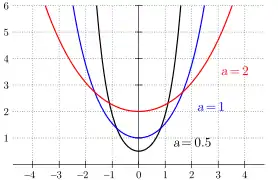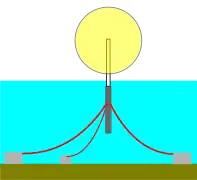catenary
English
Etymology 1
From Latin catenarius, from Latin catēna (“chain”).
Adjective
catenary (comparative more catenary, superlative most catenary)
- Relating to a chain; like a chain.
- 1997, S.A.M. Adshead, Material Culture in Europe and China, 1400–1800: The Rise of Consumerism, →ISBN:
- In Europe, the organizer was the hostess and her principle was catenary.
- 1983, Keith Godfrey, Compartmental Models and Their Application, page 242:
- The structure of the model chosen was catenary, and only one nonlinearity was introduced, in that part of the model representing bone growth.
- Relating to a catena.
- 1960, Kenya. Dept. of Agriculture, Soil Survey of the Songhor Area, Kenya, page 93:
- The sequence of soils of a more or less catenary nature as seen on the Martin Estate is about as follows :
Etymology 2
From Late Latin catenaria, in turn from Latin catēna (“chain”). Attested since 1788.
Noun
catenary (plural catenaries)
- (geometry) The curve described by a flexible chain or a rope if it is supported at each end and is acted upon by no other forces than a uniform gravitational force due to its own weight and variations involving additional and non-uniform forces.
- (engineering) Any physical cable, rope, chain, or other weight-supporting structure taking such geometric shape, as a suspension cable for a bridge or a power-transmission line or an arch for a bridge or roof.
- (nautical) The curve of an anchor cable from the seabed to the vessel; it should be horizontal at the anchor so as to bury the flukes.
- (transport) A cable, the segments of which between supports take a catenary geometric shape, supporting in turn an overhead conductor that provides trains, trams or trolley buses with electricity, or the combination of the conductor, the cable, and supports.
- 1958, The Railway Review: An Intelligent Survey of Transit News and Trends:
- The result was catenary being torn down several hundred feet at a time.
- 1962 April, P. W. B. Semmens, “The Netherlands Railways today”, in Modern Railways, page 241:
- The colour-lights showed up much better than the semaphores which, in spite of their approach warning boards, are not readily visible at any distance between the supports for the catenaries.
- 1977, Paul Castelhun Trimble, Interurban Railways of the Bay Area, page 119:
- The electric overhead was catenary, using 0000 contact wire, and the new railway employed the latest in electric block signal systems.
- 1995, The Channel Tunnel: Transport systems, →ISBN, page 22:
- In addition the catenary itself is divided into 1-2 km sections (corresponding to mechanical sections or tension lengths) with motorized remotely controlled sectioning off-load isolators such that only one train is likely to be immobilized at any one time as a result of an incident associated with the catenary system.
- 2009, Jan Young, Studebaker and the Railroads, volume 2, page 47:
- Overhead construction was catenary rather than a single wire to allow the use of pantographs instead of trolley poles so that speeds could be higher.
Derived terms
Translations
curve of a flexible chain
|
curve of an anchor cable
|
power lines above tracks
Gallery
 Diagram of geometric representation of catenaries
Diagram of geometric representation of catenaries Example of a buoy floating in the water with the mooring lines being in catenary curve shapes
Example of a buoy floating in the water with the mooring lines being in catenary curve shapes Catenary cable for a railroad line.
Catenary cable for a railroad line.
Further reading
 catenary on Wikipedia.Wikipedia
catenary on Wikipedia.Wikipedia  Weighted catenary on Wikipedia.Wikipedia
Weighted catenary on Wikipedia.Wikipedia  Catenary arch on Wikipedia.Wikipedia
Catenary arch on Wikipedia.Wikipedia  Overhead catenary (transportation) on Wikipedia.Wikipedia
Overhead catenary (transportation) on Wikipedia.Wikipedia
This article is issued from Wiktionary. The text is licensed under Creative Commons - Attribution - Sharealike. Additional terms may apply for the media files.